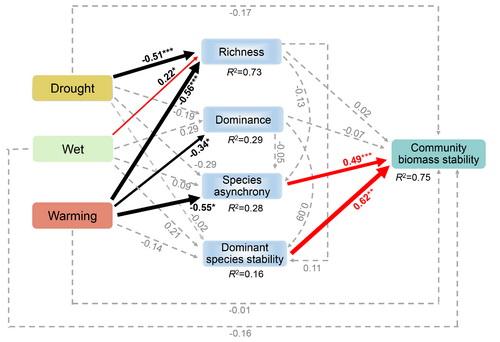【EurekAlert!】Tibetan Alpine grasslands threatened by climate warming
A warming climate will likely affect the stability of alpine grasslands in the Tibetan Plateau, threatening the ability of farmers and herders to maintain the animals that are key to their existence, and potentially upsetting the ecology of an area where important regional river systems originate, says a new study by researchers from the Northwest Institute of Plateau Biology of the Chinese Academy of Sciences, Peking University and the Georgia Institute of Technology in the United States.
Although temperature changes are likely to destabilize the fragile ecosystem of the area, variations in rainfall should not have a similar effect, according to the research, which studied two factors likely to change with a warming climate -- temperature and rainfall -- in test plots over a five-year period.
The project is believed to be the first to simultaneously examine the effects of temperature and rainfall changes on ecosystem stability.
The Tibetan Plateau is an area of about 2.5 million square kilometers where summertime high temperatures seldom exceed 25 degrees Celsius and nighttime temperatures can drop below freezing even in summer.
Due to the Plateau's altitude, temperature extremes and high winds, more than two-thirds of its area is grassland used for grazing yak, sheep and other animals. About 9.8 million people live in the area.
"Our results suggest that under a warmer climate, the ecosystem would provide less forage production in drought years, and more biomass production in wet years - which is undesirable," said HE Jinsheng, a professor in the Department of Ecology of the College of Urban and Environmental Sciences at Peking University, and an adjunct professor at the Northwest Institute of Plateau Biology, Chinese Academy of Sciences.
According to HE, "Reduced stability of plant production might also have consequences for other ecosystem services, such as climate regulation and water conservation."
The researchers found that the stability of the grasslands was affected not by the richness of plant species, but by the effects of dominant species and species synchrony.
"We found that climate warming lowers stability by increasing species synchrony so that the biomass of a few dominant species increased while that of most rare species declined," said HE. "That indicates that alpine grasslands well-adapted to cold environments due to their long-term evolutionary history may be jeopardized in the future."
The researchers studied the effects of variation in temperature and rainfall on 36 plots, reflecting six different experimental combinations of temperature and rainfall. Specifically, they varied temperature between two states (normal grasslands temperature, and two degrees higher than normal) and rainfall among three states (normal rainfall, 50 percent above normal, and 50 percent below normal) for a total of 2 X 3 = 6 experimental combinations, with six plots for each combination, or a total of 36 plots.
Over a period of five years, the researchers studied the growth of different grass species by weighing the biomass production from the different test plots. The research was conducted at the Haibei Alpine Grassland Ecosystem Research Station of the Chinese Academy of Sciences.
The study increases knowledge about the Tibetan Plateau, which has not been studied well due to its geographical isolation and harsh environment.
"The Tibetan plateau is sometimes called the 'Third Pole' because the area has so many high mountains and so much of it is covered with snow and ice," said JIANG Lin, a professor in the School of Biological Sciences at the Georgia Institute of Technology in Atlanta. "Ecologically, it is a very important region, but relatively few ecological studies have ever been done there."
Results of the study appeared in "Climate warming reduces the temporal stability of community biomass production," which was published in the journal Nature Communications.
###
The research project was funded by the National Basic Research Program of China, the National Nature Science Foundation of China, the U.S. National Science Foundation, and the 111 Project of China.
From: EurekAlert!

The structural equation model considered all plausible pathways through which experimental treatments influence community biomass temporal stability.



 青公网安备 63010402000197号
青公网安备 63010402000197号